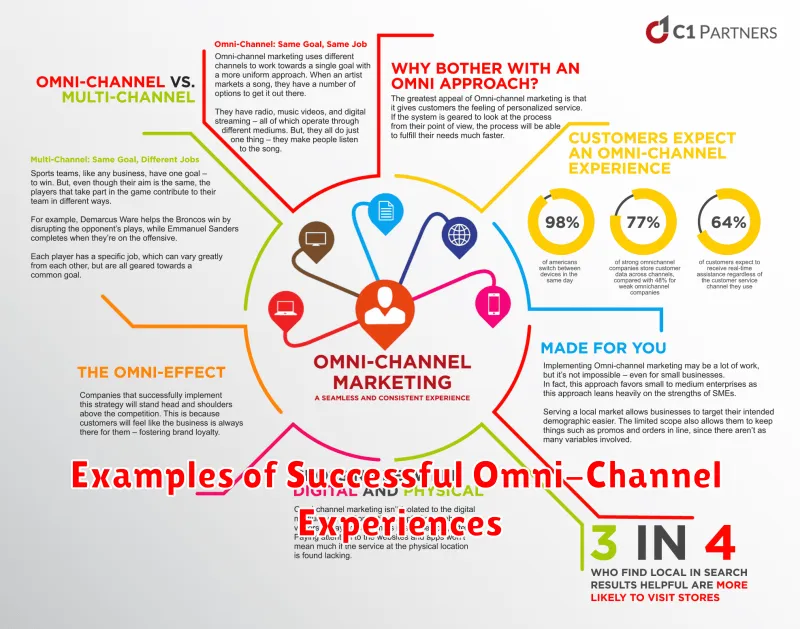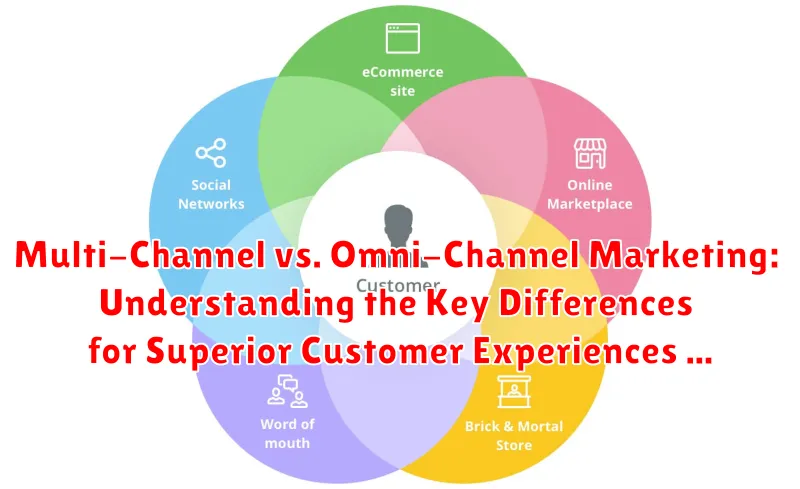In today’s customer-centric marketplace, businesses are constantly seeking innovative strategies to enhance customer experiences and drive marketing effectiveness. Two prevalent approaches, multi-channel and omni-channel marketing, often get conflated, yet represent distinct philosophies with significant implications for how brands interact with their audience. Understanding the nuances between these strategies is paramount for any organization aiming to cultivate lasting customer relationships and achieve a competitive edge. This article delves into the core differences between multi-channel and omni-channel approaches, exploring their advantages and disadvantages, and ultimately equipping you with the knowledge to determine the optimal strategy for your business needs.
As marketing evolves, businesses increasingly recognize the importance of delivering seamless and consistent experiences across all touchpoints. While multi-channel marketing focuses on simply being present on various channels (e.g., social media, email, website, in-store), omni-channel marketing takes it a step further by integrating these channels to create a unified and personalized customer journey. This means that a customer’s interaction on one channel informs and enhances their experience on another. The goal is not just to be everywhere but to provide a cohesive and relevant experience regardless of how a customer chooses to engage with your brand. Let’s explore how this distinction translates into real-world applications and strategic advantages, enabling superior customer experiences and improved business outcomes.
Defining Multi-Channel Marketing
Multi-channel marketing involves utilizing various distinct channels to reach customers. These channels operate independently, with limited or no integration between them. The primary goal is to increase brand presence and provide customers with multiple options for interacting with the business.
Common examples of multi-channel marketing include:
- Email Marketing: Sending promotional emails and newsletters.
- Social Media Marketing: Engaging with customers on platforms like Facebook, Instagram, and Twitter.
- Retail Stores: Maintaining physical brick-and-mortar locations.
- Website: Providing information and enabling online purchases.
- Mobile App: Offering a dedicated app for mobile users.
In a multi-channel approach, a customer might receive an email promotion but would not necessarily see that same promotion reflected on the company’s website or social media channels. Each channel functions as a separate entity, potentially leading to inconsistent messaging and a fragmented customer experience.
Understanding Omni-Channel Marketing
Omni-channel marketing represents a more integrated and customer-centric approach compared to multi-channel strategies. It focuses on providing a seamless and consistent brand experience across all available channels and devices. The core principle of omni-channel is to recognize that customers may interact with a business through multiple touchpoints during their buying journey, and each interaction should be cohesive and contextually relevant.
In essence, omni-channel creates a unified system where channels are interconnected, allowing customers to transition effortlessly between them. For example, a customer might browse products on a mobile app, add items to their cart, and then complete the purchase on a desktop computer, or even in a physical store, without losing their progress or experiencing inconsistencies in pricing or availability. This holistic approach significantly enhances customer satisfaction and brand loyalty.
The key differentiator is the integration of channels, where data flows freely between them. This enables a brand to have a single view of the customer, regardless of how or where they choose to interact. This unified view facilitates personalized communication, targeted offers, and more efficient customer service.
Key Differences Between Multi-Channel and Omni-Channel
The core distinction between multi-channel and omni-channel marketing lies in the level of integration and customer experience.
Multi-channel marketing involves utilizing multiple channels (e.g., email, social media, in-store) to reach customers, but these channels typically operate independently. The customer experience may be fragmented and inconsistent across different channels.
In contrast, omni-channel marketing creates a unified and seamless customer experience across all channels. Channels are integrated, allowing customers to start a journey on one channel and continue it on another without interruption. Data is shared across all touchpoints to provide a consistent and personalized experience.
Essentially, multi-channel is about presence on many channels, while omni-channel is about providing a unified experience across all channels.
Benefits of Implementing an Omni-Channel Strategy
Implementing an omni-channel strategy offers numerous advantages for businesses seeking to enhance customer experiences and drive growth. The core benefit lies in the ability to provide a seamless and consistent brand experience across all touchpoints.
Here are some key benefits:
- Enhanced Customer Satisfaction: By meeting customers where they are and providing a consistent experience, satisfaction increases.
- Increased Customer Loyalty: A unified and personalized experience fosters stronger customer relationships and loyalty.
- Improved Brand Perception: A cohesive omni-channel presence enhances brand image and credibility.
- Higher Conversion Rates: Streamlined purchasing processes across channels lead to increased sales.
- Better Data Collection & Insights: Omni-channel strategies facilitate comprehensive data collection, enabling better understanding of customer behavior.
- Increased Revenue: Improved customer experiences and higher conversion rates translate directly into increased revenue.
Ultimately, an omni-channel strategy allows businesses to cultivate deeper customer relationships, optimize marketing efforts, and achieve significant gains in revenue and market share.
Examples of Successful Omni-Channel Experiences

Several companies have successfully implemented omni-channel strategies, resulting in improved customer satisfaction and increased revenue. These examples highlight how a seamless and integrated experience can benefit both the customer and the business.
Disney
Disney offers a prime example. Customers can plan their trips online or through the My Disney Experience app, make reservations, and even use MagicBands to access parks, unlock hotel rooms, and make purchases. This creates a cohesive and personalized experience from initial planning to on-site engagement.
Starbucks
Starbucks’ rewards program is another strong example. Customers can order ahead through the app, pay in-store, and earn rewards that can be redeemed across various channels. Their experience is unified whether they are ordering online, in a store, or via the drive-through.
REI
REI (Recreational Equipment, Inc.) provides a seamless experience for outdoor enthusiasts. Customers can research products online, check in-store availability, and even order online for in-store pickup. Their knowledgeable staff further enhances the experience, creating a strong connection between the digital and physical realms.
Challenges in Implementing Omni-Channel Marketing
Implementing an omni-channel marketing strategy presents several significant challenges for businesses. These challenges often stem from the complexity of integrating various marketing channels and ensuring a seamless customer experience across all touchpoints.
One major hurdle is data silos. Many organizations struggle to consolidate customer data from different channels into a unified view. This lack of integration can hinder personalization efforts and make it difficult to track customer journeys effectively.
Another challenge is the need for cross-departmental collaboration. Omni-channel requires marketing, sales, customer service, and IT departments to work together seamlessly. Siloed operations and a lack of communication can derail the entire strategy.
Furthermore, technology infrastructure plays a critical role. Organizations need to invest in robust technology platforms that can support data integration, personalization, and real-time communication across all channels. Legacy systems and outdated technologies can be significant barriers.
Finally, measuring ROI can be difficult. Attributing sales and conversions to specific touchpoints in an omni-channel environment requires sophisticated analytics and attribution modeling.
Building an Omni-Channel Strategy: A Step-by-Step Guide
Developing a robust omni-channel strategy requires careful planning and execution. Here’s a step-by-step guide to get you started:
- Define Your Target Audience: Understand their needs, preferences, and behavior across different channels.
- Map the Customer Journey: Visualize how customers interact with your brand at each touchpoint. Identify pain points and opportunities for improvement.
- Choose the Right Channels: Select the channels that are most relevant to your target audience and align with their journey.
- Integrate Your Technology: Ensure that your CRM, marketing automation, and other systems are integrated to provide a seamless customer experience.
- Personalize the Experience: Use data to personalize your messaging and offers across all channels.
- Test and Optimize: Continuously monitor your results and make adjustments to your strategy as needed.
By following these steps, you can create a powerful omni-channel strategy that delivers superior customer experiences and drives business growth.
The Role of Technology in Enabling Omni-Channel
Technology is the backbone of a successful omni-channel strategy. It bridges the gap between different customer touchpoints, ensuring a seamless and consistent experience across all channels.
Here are key technological components:
- CRM (Customer Relationship Management) Systems: Centralize customer data, providing a unified view of customer interactions.
- Marketing Automation Platforms: Automate marketing tasks across channels, delivering personalized messaging.
- E-commerce Platforms: Provide a consistent online shopping experience across devices.
- Mobile Applications: Offer convenient access to products, services, and support on the go.
- Data Analytics Tools: Track customer behavior across channels, providing insights for optimization.
Without these technologies, achieving true omni-channel integration is nearly impossible. The right technology stack empowers businesses to deliver personalized, relevant, and consistent experiences at every touchpoint.
Measuring the Success of Your Omni-Channel Initiatives

To ascertain the effectiveness of your omni-channel marketing strategy, it’s crucial to establish clear Key Performance Indicators (KPIs) and rigorously track them. These metrics should align with your overall business objectives and provide insights into customer behavior and engagement across all channels.
Here are some important metrics to consider:
- Customer Lifetime Value (CLTV): Omni-channel experiences should increase CLTV by fostering stronger customer relationships.
- Customer Acquisition Cost (CAC): Assess whether omni-channel efforts improve acquisition efficiency.
- Channel Attribution: Understanding which channels contribute most to conversions is crucial.
- Customer Satisfaction (CSAT) & Net Promoter Score (NPS): Measure customer sentiment to gauge the overall experience.
- Conversion Rates: Track conversion rates across different channels and touchpoints to identify areas for improvement.
Regularly analyze these KPIs to identify trends, optimize your strategy, and demonstrate the ROI of your omni-channel investments. Using analytics tools, you can gain deeper insight into customer journeys and make data-driven decisions to enhance the customer experience.
Future Trends in Omni-Channel Marketing
The landscape of omni-channel marketing is constantly evolving, driven by technological advancements and shifting consumer expectations. Several key trends are poised to shape the future of this strategy.
Artificial Intelligence (AI) and Machine Learning (ML) are playing an increasingly significant role. Expect to see more sophisticated personalization, predictive analytics for customer behavior, and AI-powered chatbots providing seamless support across channels.
Augmented Reality (AR) and Virtual Reality (VR) will create immersive shopping experiences, blurring the lines between the physical and digital worlds. Consumers can virtually “try on” products or visualize furniture in their homes before making a purchase.
Voice Commerce continues to gain traction. Optimizing your omni-channel strategy for voice search and voice-activated purchases will be crucial. This includes integrating with voice assistants like Alexa and Google Assistant.
Hyper-Personalization will move beyond basic segmentation to deliver truly individualized experiences. Leveraging data to understand customer preferences and anticipate their needs will be paramount.

